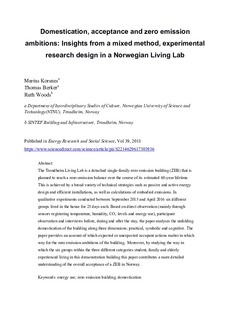| dc.contributor.author | Korsnes, Marius | |
| dc.contributor.author | Berker, Thomas | |
| dc.contributor.author | Woods, Ruth | |
| dc.date.accessioned | 2017-12-07T07:43:20Z | |
| dc.date.available | 2017-12-07T07:43:20Z | |
| dc.date.created | 2017-12-06T14:46:29Z | |
| dc.date.issued | 2018 | |
| dc.identifier.issn | 2214-6296 | |
| dc.identifier.uri | http://hdl.handle.net/11250/2469463 | |
| dc.description.abstract | The Trondheim Living Lab is a detached single-family zero emission building (ZEB) that is planned to reach a zero-emission balance over the course of its estimated 60-year lifetime. This is achieved by a broad variety of technical strategies such as passive and active energy design and efficient installations, as well as calculations of embodied emissions. In qualitative experiments conducted between September 2015 and April 2016 six different groups lived in the house for 25 days each. Based on direct observation (mainly through sensors registering temperature, humidity, CO2 levels and energy use), participant observation and interviews before, during and after the stay, the paper analyses the unfolding domestication of the building along three dimensions; practical, symbolic and cognitive. The paper provides an account of which expected or unexpected occupant actions matter in which way for the zero emission ambitions of the building. Moreover, by studying the way in which the six groups within the three different categories student, family and elderly experienced living in this demonstration building this paper contributes a more detailed understanding of the overall acceptance of a ZEB in Norway. | nb_NO |
| dc.language.iso | eng | nb_NO |
| dc.publisher | Elsevier | nb_NO |
| dc.rights | Attribution-NonCommercial-NoDerivatives 4.0 Internasjonal | * |
| dc.rights.uri | http://creativecommons.org/licenses/by-nc-nd/4.0/deed.no | * |
| dc.title | Domestication, acceptance and zero emission ambitions: Insights from a mixed method, experimental research design in a Norwegian Living Lab | nb_NO |
| dc.type | Journal article | nb_NO |
| dc.type | Peer reviewed | nb_NO |
| dc.description.version | acceptedVersion | nb_NO |
| dc.source.volume | 39 | nb_NO |
| dc.source.journal | Energy Research & Social Science | nb_NO |
| dc.identifier.doi | 10.1016/j.erss.2017.11.004 | |
| dc.identifier.cristin | 1523666 | |
| dc.relation.project | Norges forskningsråd: 209697 | nb_NO |
| dc.description.localcode | © 2017. This is the authors’ accepted and refereed manuscript to the article. LOCKED until 6.12.2019 due to copyright restrictions. This manuscript version is made available under the CC-BY-NC-ND 4.0 license http://creativecommons.org/licenses/by-nc-nd/4.0/ | nb_NO |
| cristin.unitcode | 194,62,40,0 | |
| cristin.unitname | Institutt for tverrfaglige kulturstudier | |
| cristin.ispublished | true | |
| cristin.fulltext | postprint | |
| cristin.qualitycode | 1 | |

